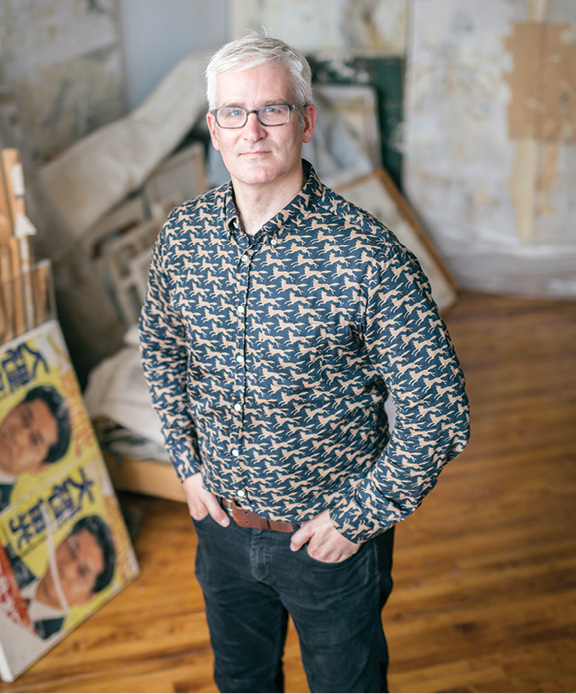Vanderbilt’s global high profile means more students from overseas

The number of international students seeking to study in the United States has exploded during the past 15 years. Last year more than 886,000 international students enrolled in U.S. universities, marking a new record high and a 72 percent increase since 2000. Not surprisingly, the surging Chinese middle class has driven much of the recent growth, though countries like India, South Korea, Japan and, increasingly, Persian Gulf states have been major contributors as well.
Helping American universities like Vanderbilt navigate this growing demand from students abroad is Clay Hensley, BA’94. Hensley, a recipient of Vanderbilt’s prestigious Grantland Rice–Fred Russell Scholarship who grew up in a small town in West Tennessee, serves as senior director of international strategy and outreach for the College Board, which is best known for the SAT and AP tests. Shortly after college—and an M.F.A. from the University of Tennessee, Knoxville—he moved to New York City, where he fell into a job at the College Board as a way to support his artistic ambitions. But now he says it’s a role he treasures—and one that has given him the privilege of working in more than 70 countries and counting.
Is the growing number of international students coming to the U.S. a byproduct of the China boom, or are there other factors at play?
When I first started working at the College Board in 2000, the largest number of international students came from Japan for undergraduate study. China and India have been sending a substantial number of graduate students to the U.S. for many years. However, for undergraduates that number was incredibly small compared to today’s numbers. Around 2006–07, for a variety of reasons—including the expansion of the Chinese middle class and more liberal U.S. visa policies following a contraction after Sept. 11—the number of Chinese students both interested in and pursuing higher education at the undergraduate level in the U.S. has exploded. That’s been the big story when you look at international engagement by American universities, which are trying to take advantage of that growth while also controlling it so they’re not drinking from a firehose. Vanderbilt in particular has been thoughtful, deliberate and responsible about choosing Chinese students who really fit well into its university community.
In addition to China—when it comes to students actually arriving, matriculating and enrolling—the other place with strong growth is the Persian Gulf. Saudi Arabia, the United Arab Emirates, Qatar, Oman. These are all places where local governments are funding significant scholarship programs.
What’s driving the demand?
The attraction of U.S. higher education is immense. For starters, U.S. institutions have an extremely high profile globally. The U.S. would make up a significant part of any list of top global schools—Vanderbilt among them. I also think there’s an attraction to the American style of higher education, what we loosely call a “liberal arts model,” in which students aren’t locked into a particular discipline too early. English is a major draw, too. China, South Korea, member states of the Association of Southeast Asian Nations, and the Gulf countries all benefit tremendously from having fluent English speakers.
Do international students tend to seek particular fields of study?
In an emerging market like China, the growth in demand for U.S. higher education has been dominated by business management and economics. That’s the skill set that will get jobs. For India it’s STEM fields, particularly engineering. And once you add STEM fields for China, that accounts for about 80 percent of their majors. For countries like South Korea and Japan, we saw a phenomenon in which business management and STEM fields originally attracted most of the students, but as those markets grew, the areas of study began to diversify into a wider array of the social sciences and the arts. That’s starting to happen with China, and I anticipate it will undergo a similar phenomenon.
Has the growth in international demand made admissions more competitive for U.S. students?
It does play a role. U.S. college admissions is getting more competitive overall, and it’s also getting more competitive for international students, especially for top schools. Vanderbilt now has about 7 percent of its undergraduate enrollment coming from abroad, which is typical of a top-tier U.S. institution (and more than when I attended). That said, I think the greater selectivity has more to do with mobility within the U.S.—and a much larger number of students applying to a greater number of universities. So yes, I think international students applying to U.S. universities is one factor—but not a main factor—in making admissions more selective for U.S. students.
Can you talk about being an artist in New York?
Even though I was an English lit major—there wasn’t a visual arts major at the time—I continue to have a studio and have shown my work in pop-up galleries in Brooklyn and in Massachusetts, Michigan and Georgia. While I spent a lot of time with art professors Don Evans and Marilyn Murphy, several English professors had an impact on what I do visually, including Cecelia Tichi, Bill Engel and Margaret Bass. They all had a huge impact on the way I looked at the world. In terms of my art, I excavate surfaces from existing sites. I call them urban palimpsests—things that look like they should be paintings. They look like they should be a Cy Twombly, but they’re not. They look like a Jean Dubuffet, but they’re not. It also allows me to travel and still do art. I can excavate these things while I’m on the road and then bring them back to the studio when I get home.
Clay Hensley (@clayhensley) was interviewed by Editor Ryan Underwood, BA’96.